IN/SITU
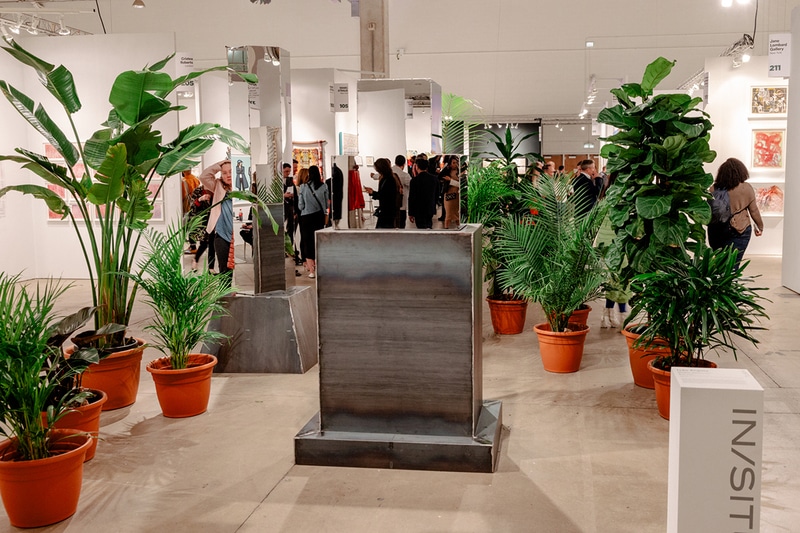
Iván Argote, Etcétera: Bust, 2021 and Etcétera: Column, 2021 at EXPO CHICAGO 2024. Mirror-polished stainless Cor-Ten steel. Courtesy of the artist and Perrotin, Paris, New York, Hong Kong, Seoul, Tokyo, Shanghai, Dubai, Los Angeles. Photo by Evan Jenkins.
Installed within the expansive, vaulted architecture of Navy Pier’s Festival Hall, IN/SITU features large-scale sculpture, video, film and site-specific works. For the 2024 program, Amara Antilla, Independent Curator and Guest Curator at Contemporary Arts Center (CAC) in Cincinnati, curated a selection of new and existing works featuring artists from leading international exhibitors participating in the exposition.
2024 IN/SITU Curator
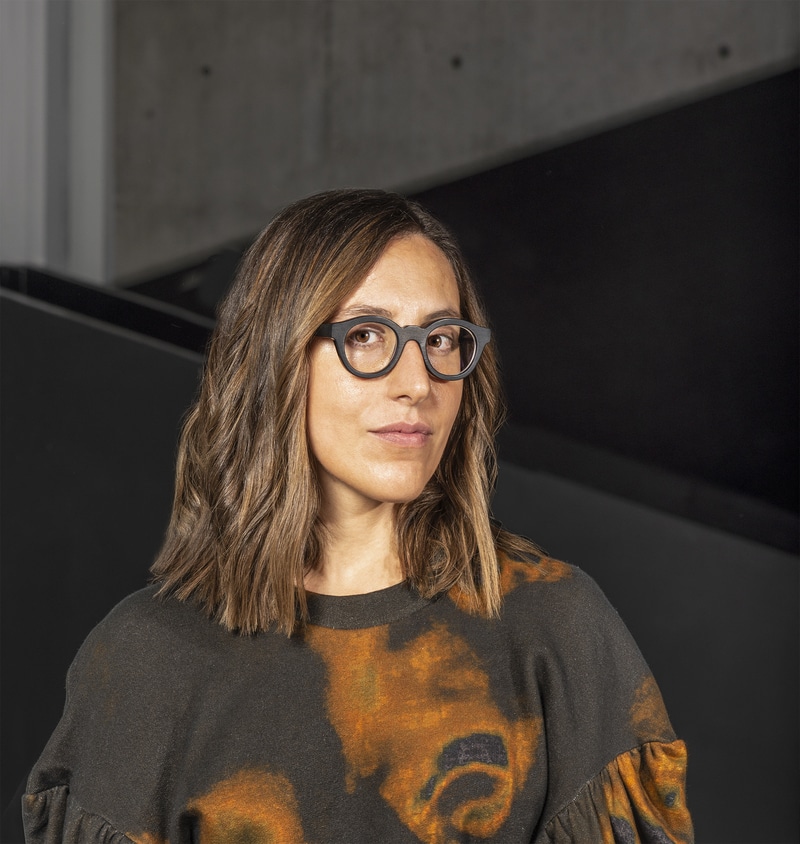
Amara Antilla, EXPO CHICAGO 2024 IN/SITU Curator. Photo by Jesse Ly.
Amara Antilla is a curator based in Washington DC with over fifteen years of experience conceiving of and developing exhibitions with a focus on international contemporary art. She is currently an independent curator and guest curator for Contemporary Arts Center (CAC) in Cincinnati. From 2019 to 2023 she served as Senior Curator at the CAC where she organized solo exhibitions and new commissions by artists including Tania Candiani (2020), Kahlil Robert Irving (2020), Steffani Jemison (2021), Marwa Arsanios (2021), Hellen Ascoli (2021), Rit Premnath (2021), Nora Turato (2021), Paul Maheke (2022), Carmen Winant (2022) and Tai Shani (2023). Among the group exhibitions that she has recently curated and co-curated are Wild Frictions: The Politics and Poetics of Interruption (2021); The Regional (2022), Artist-Run Spaces (2022), and Breaking Water (2022). Antilla’s projects have traveled to or been featured at venues such as the Dhaka Art Summit; ICA San Diego; JOAN, Los Angeles; Kunstraum Kreuzberg, Berlin; The Kemper Museum of Contemporary Art, Kansas City, and Northern Spark, Minneapolis, among others. Previously, Antilla served as a curator at the Guggenheim Museum in New York, where she worked on numerous exhibitions and expanded the permanent collection through acquisitions. She also supported the research and exhibition program of the MAP Global Art Initiative and contributed to organizing various contemporary exhibitions and performances with artists including Simone Leigh, Alfredo Jaar, and Amalia Pica. She is the recipient of the Andy Warhol Foundation Curatorial Research Fellowship and the Emily Hall Tremaine Exhibition Research Award (both 2022). She studied art history at Tufts University, Medford, the School of the Museum of Fine Arts, Boston, and Hunter College of the City University of New York (CUNY).
CURATORIAL STATEMENT: In the Country of Last Things, IN/SITU 2024
Titled after Paul Auster’s 1987 dystopian novel, the 2024 IN/SITU section presents site-responsive and large-scale work in installation, painting, photography, sculpture, sound, and video by fifteen artists examining the precarious nature of contemporary life. Anchored by Lucia Koch’s monumental installation of photographs depicting the void-like interiors of discarded cardboard containers, the exhibition explores themes of systemic economic failure, ecological instability, and political dissolution. Produced by an international cohort of artists, many of whom have ties the Midwest, the featured projects investigate collective unease during a fractured time, evoking revisionist histories, and moving beyond critique to imagine more just and sustainable futures.
2024 Participating Artists
American Artist | Labor, Mexico City
Iván Argote | Perrotin, Paris, New York, Hong Kong, Seoul, Tokyo, Shanghai, Dubai, Los Angeles
Paul Stephen Benjamin | Efraín López, New York
Kiah Celeste | DOCUMENT, Chicago, Lisbon & Swivel Gallery, Brooklyn
Elena Damiani | Revolver Galería, Lima, Buenos Aires, New York
Anne-Karin Furunes | RYAN LEE Gallery, New York
Rico Gatson | Miles McEnery, New York
Maria Hupfield | Patel Brown, Toronto, Montreal
Voluspa Jarpa | NOME, Berlin
Lucia Koch | Nara Roesler, São Paulo, Rio de Janeiro, New York
Josèfa Ntjam | Galerie Poggi, Paris
Michael Rakowitz | Rhona Hoffman Gallery, Chicago & Jane Lombard Gallery, New York
Claudia Peña Salinas | CURRO, Guadalajara
Tori Wrånes | Nazarian / Curcio, Los Angeles
Lauren Yeager | Abattoir, Cleveland
2024 ON-SITE WORKS
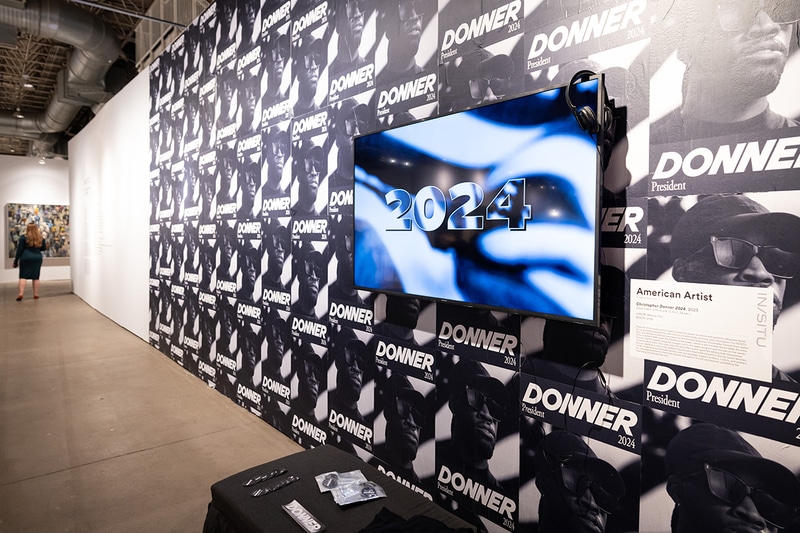
American Artist
Labor, Mexico City
Christopher Donner 2024, 2023
Color video, with sound. 2 min., 22 sec.
Courtesy of the artist and Labor, Mexico City.
American Artist works across media to examine power dynamics and systemic inequities faced by marginalized populations, with a focus on technology, policing, and information. For IN/SITU they have devised a political campaign for the fictional character Christopher Donner from writer Octavia Butler's 1993 speculative novel The Parable of the Sower, which is set in a then-future 2024 America. Donner’s bid for support incorporates an anti-space stance that proposes budget cuts to the space program and focuses on the needs of earthly Americans. The video uses the slick effects and rapid-fire editing that characterize popular media as a nod to the celebrity figures who have entered politics during recent election cycles. Employing promotional devices such as campaign slogans, buttons, t-shirts, and posters, the campaign extends to interstitial spaces throughout the fair and beyond, paralleling the impending US presidential race.
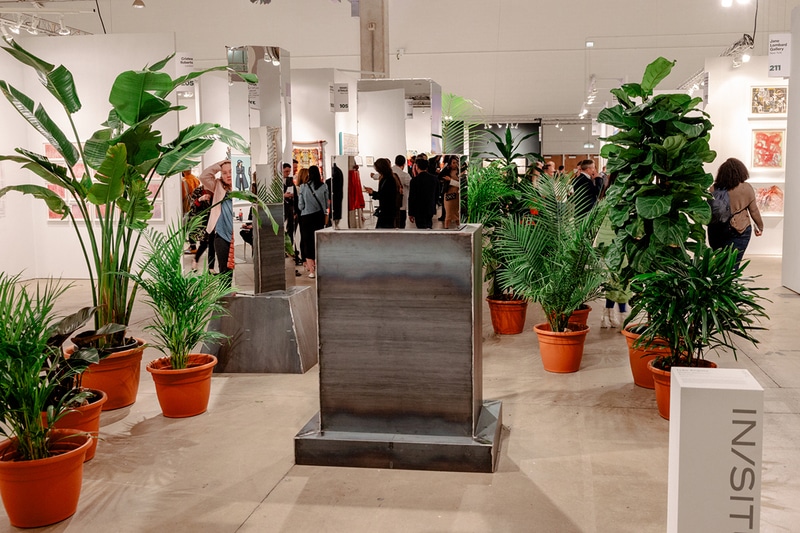
Iván Argote
Perrotin, Paris, New York, Hong Kong, Seoul, Tokyo, Shanghai, Los Angeles
Etcétera: Bust, 2021 and Etcétera: Column, 2021
Mirror-polished stainless Cor-Ten steel. 106 11/16 x 23 5/8 x 27 15/16 in. and 81 1/2 x 42 15/16 x 31 1/8 in.
Courtesy of the artist and Perrotin, Paris, New York, Hong Kong, Seoul, Tokyo, Shanghai, Dubai, Los Angeles
Iván Argote works with sculpture, installation, performance, and video to explore legacies of colonialism with a focus on his native Colombia and his current home, France. Over the past 15 years, Argote has intervened with monuments and other physical signifiers of Western power, dismembering, covering, and sometimes even staging their removal. The objects included in IN/SITU feature reflective blocks mounted on generic plinths, mimicking the format of a traditional bust and column. The objects’ mirror-like surfaces reflect the surrounding space in a way that renders them almost invisible. The installation refers to an action staged by Argote in Parc National, Bogotá, in 2011, in which he covered a monument to Spanish conquistador Francisco de Orellana—who “discovered” the Amazon—in mirrors. A photo of the intervention shows a tall stone base topped with what appears to be reflected vegetation. This near erasure temporarily shifted the focus away from de Orellana back to the natural world in a symbolic act of reparation for the continued environmental toll of colonialism, capitalist expansionism, and extractivism.

Paul Stephen Benjamin
Efraín López, New York
Black Flag, 2022
Black cotton, custom flagpole. 120 x 50 x 80 in.
Courtesy the artist and Efraín López, New York
For the past two decades, Paul Stephen Benjamin has examined the subject of Blackness from aesthetic, cultural, historical, and sociopolitical perspectives. Black Flag features a large American flag hanging from a black flagpole by one corner, a gesture that places it within a history of flag modification by individuals—especially artists and activists—as an act of dissent and protest. The black flag in particular was adopted by the anarchist and punk movements as a signifier of resistance to authority and capitalism. In 2021, a right-wing faction of Trump supporters began hanging black flags outside their homes as a nod to the defiant 17th century military slogan “no quarter given.” This was an apparent rebuttal to liberal counterparts during a time of heightened political tension. By presenting the American flag on the floor, Benjamin intensifies his critique of this national symbol.
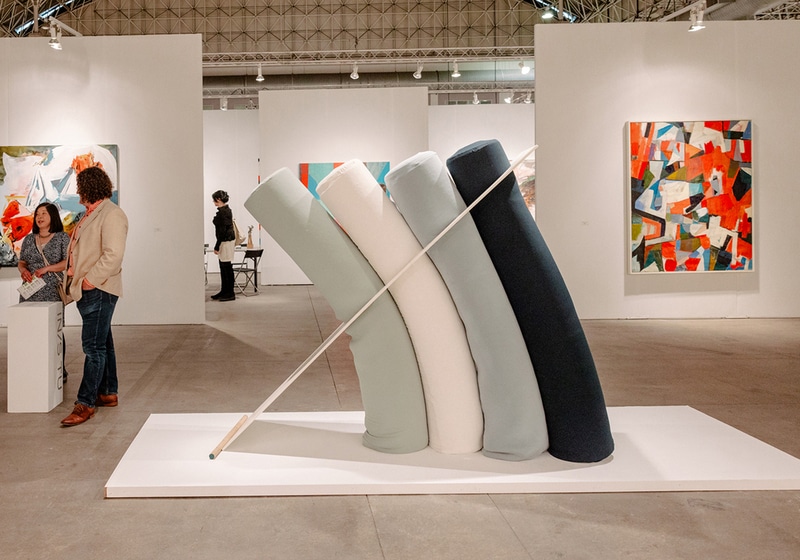
Kiah Celeste
DOCUMENT, Chicago, Lisbon & Swivel Gallery, Brooklyn
Aloof it all, 2024
Carpet padding, fabric, Corian, wood. 66 x 24 x 98 in.
Courtesy of the artist, DOCUMENT Chicago | Lisbon, and Swivel Gallery, Brooklyn.
Kiah Celeste produces sculptures and installations using everyday materials associated with both household and industrial use, such as steel, latex, rubber, stone, and fabric. She explores basic concepts in physics by arranging objects and environments to explain relationships between different types of matter. These projects also pose metaphorical questions around the principles of balance and precarity in individual and collective contexts. Leaning, stacking, or hanging, her works echo the strategies of postminimalism in their harnessing of gravity, tension, friction, and resistance. In Aloof It All, four fabric-wrapped pieces of carpet-padding in shades of green are held in place by a slab of corian. Functioning as surrogates for bodies in space, the elements lean as if embracing to achieve balance despite a great discrepancy in volume between their soft and hard components. Through this precarious interaction, Celeste raises questions about the possibility of finding inner resilience and societal equilibrium.
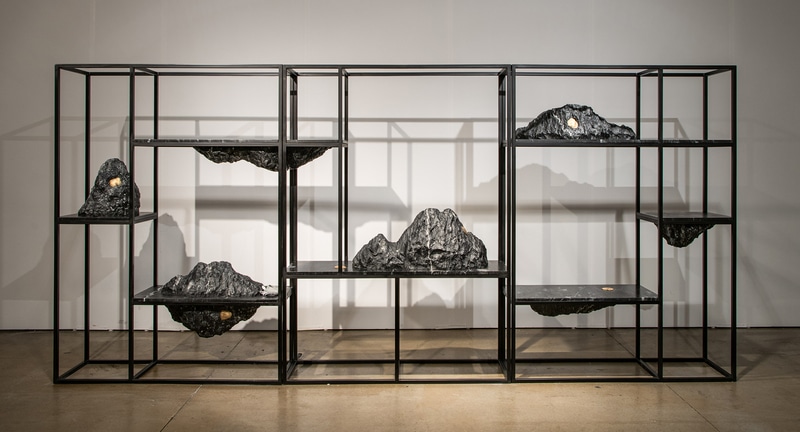
Elena Damiani
Revolver Galería, Lima, Buenos Aires, New York
Suns in the shadow, 2022
Hand-carved and polished Santa Ana marble, bronze casting, steel, polyurethane paint and lacquer. 83 x 177 x 17 inches.
Courtesy of the artist and Revolver Galería, Lima Buenos Aires, New York.
Elena Damiani works with sculpture, installation and photography to examine existential questions related to history and time through studies of the earth and the cosmos. For Suns in the shadow, Damiani merges a rectilinear shelf structure with black marble formations that protrude organically from the grid-like frame in irregular patterns. Disks of bronze are scattered throughout the marble, suggesting a phenomenon known as pyrite suns, in which mineral sedimentation spreads out horizontally under immense pressure over thousands of years. These circular patterns typically form in areas of organic matter, indicating the presence of early forms of life. The work relates to the artist's series Rude Rocks (2015-2018), which was inspired by a short story by Argentinian writer Jorge Luis Borges that describes notions of infinity and immeasurability as deeply unsettling concepts. Suns in the shadow draws parallels between the scale of planetary bodies and that of tiny crystalline formations deep within the earth, where in both cases their origins and futures lie beyond human comprehension.
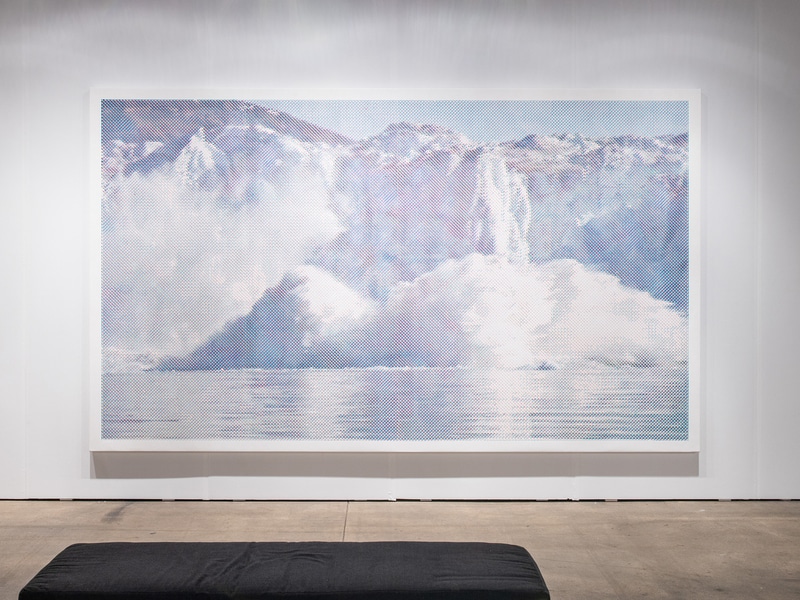
Anne-Karin Furunes
RYAN LEE Gallery, New York
Calving Glacier XI, Kronebreen, Svalbard, 2023
Acrylic on canvas, perforated. 78 3/4 x 142 in.
Courtesy of the artist and RYAN LEE, New York.
Working with a process akin to printmaking, Anne-Karin Furunes produces paintings and large-scale works that memorialize images sourced from public archives. Her pictures, which are legible only at a distance and seem to shift based on the viewer’s position, are made by applying tiny acrylic dot patterns in cyan, magenta, yellow, and black (CMYK) pigments, then perforating the canvas in a pattern that transforms light and shadow into a suggestion of form. In this chilling work, Furunes captures the shedding of glaciers on the Nordic archipelago of Svalbard, where temperatures are rising at an unmatched rate. The conditions offer an apt case study for the future impact of climate change globally, where flora and fauna, sea levels and temperatures, glacier integrity, and the overall ecosystem is already altered to an unprecedented and cautionary degree.
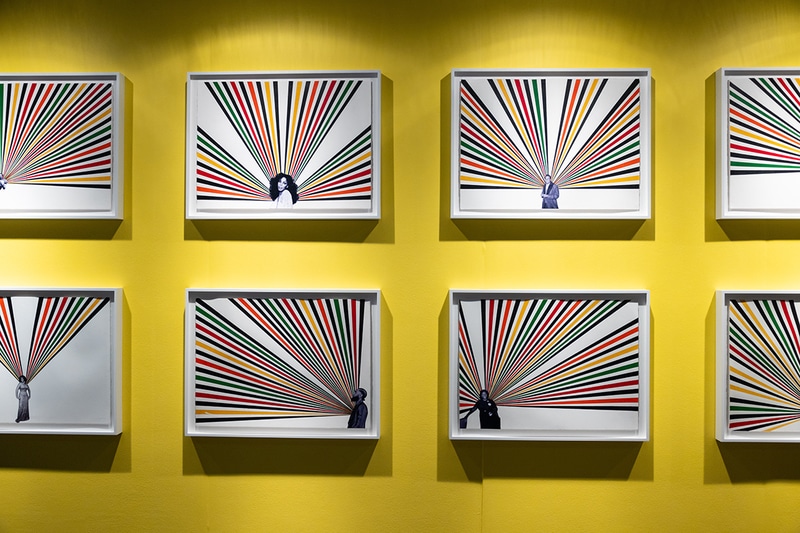
Rico Gatson
Miles McEnery, New York
An installation of recent framed works on paper from the ongoing "Icon" series, 2024
Ink on paper. Dimensions variable
Courtesy the artist and Miles McEnery Gallery, New York.
Rico Gatson uses sculpture, painting, drawing, and installation to highlight spirituality and the Black experience. His ongoing “Icon” series features portraits of historical African and African American figures from politics, literature, and popular culture, set against colorful rays framing them like halos. By portraying these luminaries stripped of their original context and environment, Gatson transforms them into timeless archetypes. The compositions resemble early medieval depictions of saints or the Madonna and child and elevate these cultural icons to the status of, in the artist's words, “superheroes.” The selected color palette approximates a Pan African sensibility and features cultural sources, including Chicago-native musician, the greatest jazz drummer of all time, Tony Williams. Gatson’s “Icon” series reinscribes the creative and intellectual labor of Black people in the diaspora, across time and space, into the visual culture of the present, inviting a reassessment of historical narrative.
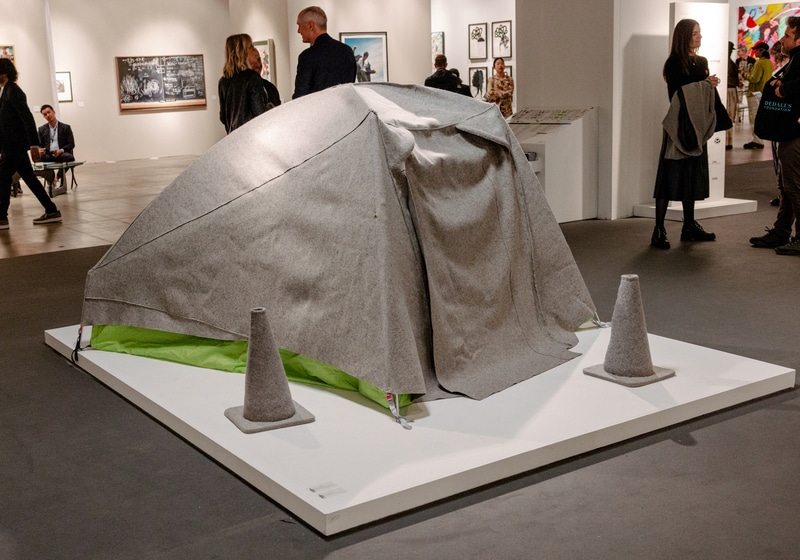
Maria Hupfield
Patel Brown, Toronto, Montreal
ABI AKI, 2022 and Distinctive, Easily Portable, and Often Stolen, 2022
Industrial felt, and nylon. 48 x 72 x 84 in. and 24 x 12 x 12 in. each
Courtesy of the artist and Patel Brown, Toronto, Montreal.
Titled after an Anishinaabe phrase meaning “to sit on the land” or “home is the land”, ABI AKI is a dwelling rendered in felt and nylon. The structure resembles a domed tent, but also calls to mind the arched willow boughs of traditional sweat lodges. Hupfield pays homage to the tent as a basic form common to non-western architecture and itinerant communities—refugees, migrants, and the unhoused—who use it to lay claim to land despite often lacking ownership of that land. The tent became an icon for Indigenous solidarity and resistance after encampments assembled at Standing Rock during protests against the Dakota Access Pipeline in 2016, and continues to represent communities that lack a home due to ongoing states of emergency and economic instability.
Combining form and function, a typical rainfly blocks the entrance to Hupfield’s work. By denying entry with an object designed to protect the interior space and its inhabitants, Hupfield invites viewers to consider their own positions in relation to land and ownership, settler colonialism, and environmental extraction. ABI AKI is displayed with three felt pylons (or traffic cones) that resemble the common props used to redirect movement or demarcate zones of safety.
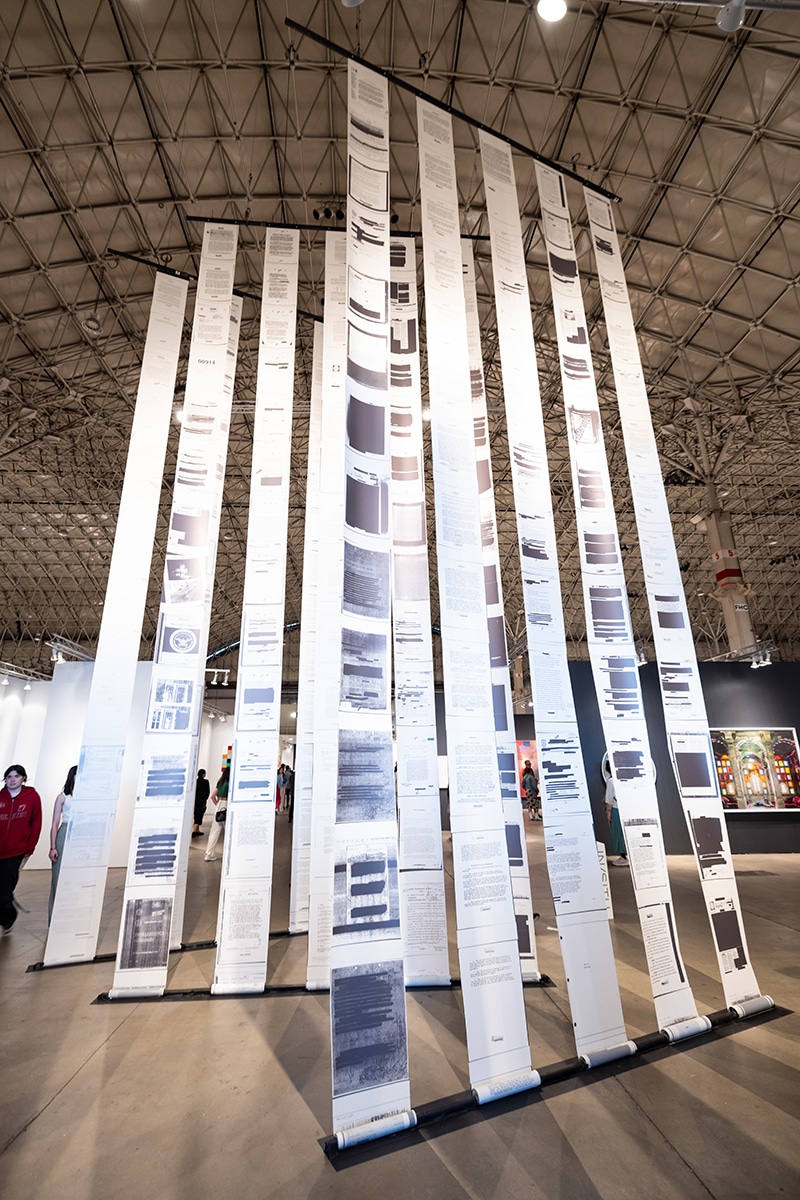
Voluspa Jarpa
NOME, Berlin
Desclasificados (Declassified), 2019
Ink on paper. Dimensions variable.
Courtesy of the artist and NOME, Berlin.
This expansive installation by Voluspa Jarpa reflects more than two decades of research into declassified CIA documents that chronicle US interventions in Leftist regimes, primarily in Latin America. In an effort to materialize the magnitude of these clandestine actions, which ultimately led to the Chilean coup d’etat and the failure of its burgeoning democracy, Jarpa has used the documents to produce a suspended partition. The documents, which date from between 1948 and 1993, are related to 14 countries and describe violations of international humanitarian law, the killing of 47 political leaders and other extrajudicial deaths, and covert political operations. However, this history remains shrouded in mystery as most of the texts are heavily redacted. The black strips of erasure create an abstract pattern that refers to strategies of disappearance and silencing characteristic of capitalist and colonialist systems. Desclasificados (Declassified) explores the power of information and the ways in which the interests of a select few can affect the course of global history for all.
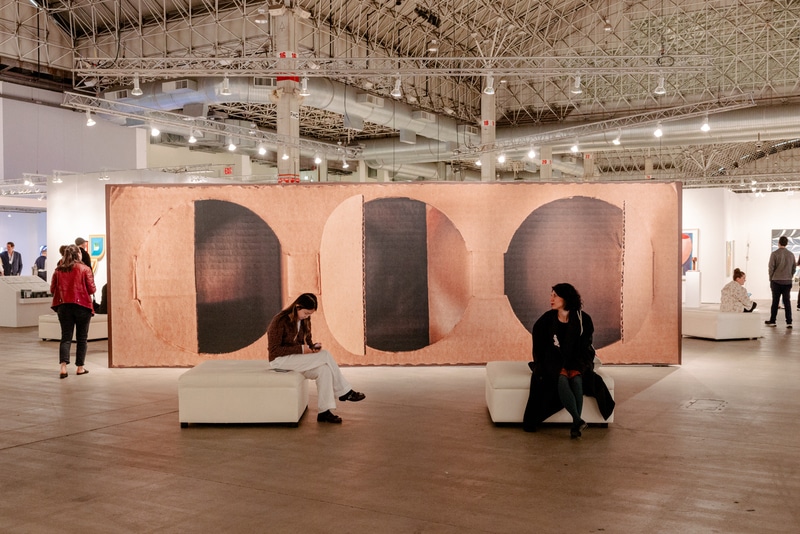
Lucia Koch
Nara Roseler, São Paulo, Rio de Janeiro, New York
3X3 Pots, 2024
Photograph on vinyl with wood. Dimensions variable.
Courtesy of the artist and Nara Roseler, São Paulo, Rio de Janeiro, New York.
Positioned at the center of Navy Pier’s Festival Hall, 3X3 Pots suggests the extension of space into another dimension. The work’s surreal imagery comes from Koch’s photographs of empty cardboard boxes, these three views documenting the interior of a container designed to hold vases. Greatly enlarged, the shots suggest architectural spaces, dwarfing the viewer. Circular openings resembling nautical windows, ducts, or vents cover three connected surfaces and relate to the surrounding industrial environment. The work is a meditation on consumption and waste, asking what is left when a space is emptied of all value.
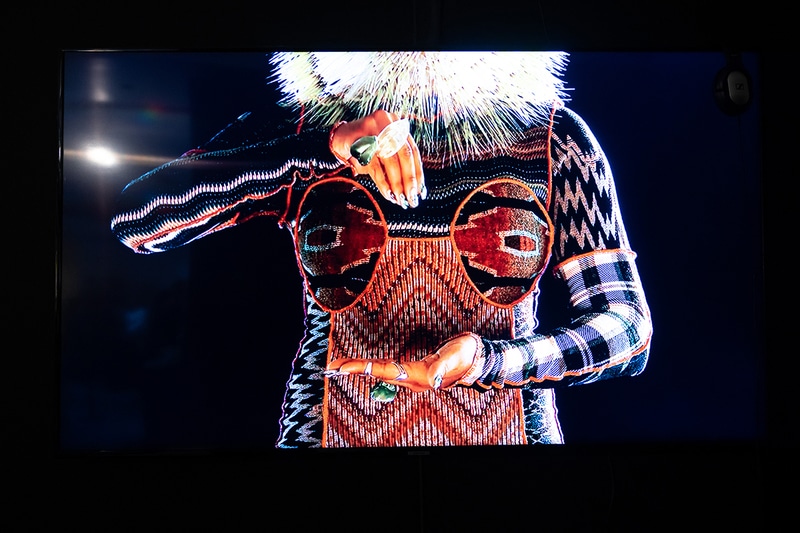
Josèfa Ntjam
Galerie Poggi, Paris
Incubateur de révolte, 2023
Steel, PVC, and LED, with monitor featuring color video, with sound, 5 min., 43 sec. 70 7/8 x 89 3/4 in.
Courtesy of the artist and Galerie Poggi, Paris.
Josèfa Ntjam’s practice spans sculpture, photography, video, sound, and installation to delve into historical liberation movements and the role that nature plays in acts of individual and collective rebellion. Drawing from diverse sources including scientific and historical archives, family photos, and imagery collected from microscopes and other biological sources, Ntjam blurs digital, handmade, and the real to craft otherworldly imaginaries. For IN/SITU Ntjam presents a video installation that echoes her research into the Maquis, rural Cameroonian freedom fighters who played a pivotal role in securing Cameroonian’s independence from France in the 1950’s. The work consists of a video of a plant-human hybrid cyborg reciting the ingredients for medicinal elixirs intended to incite revolution in the consumer. The narrator’s veiled face resembles traditional African mask motifs, but also the patterned camouflage found throughout the natural world, a strategy employed by both plants and animals intended to disguise and evade danger.
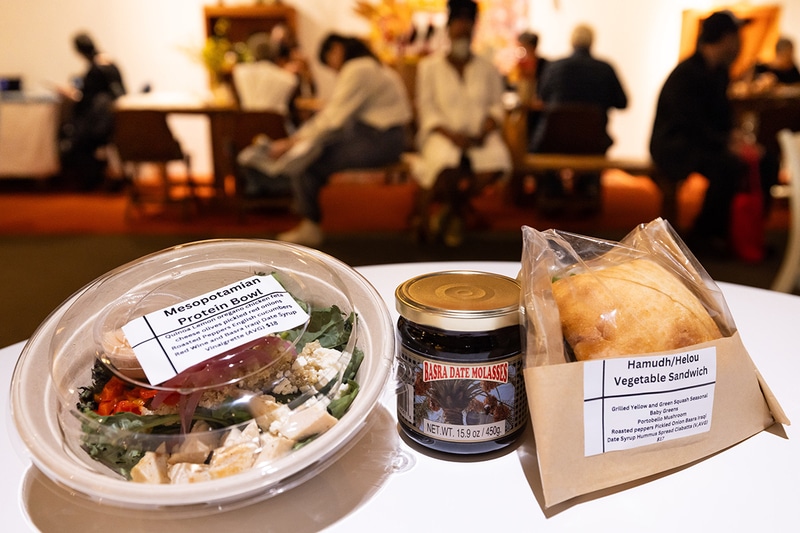
Michael Rakowitz
Rhona Hoffman Gallery, Chicago & Jane Lombard Gallery, New York
The Breakup, 2022
Sound
A house with a date palm will never starve, 2019/2024
Culinary intervention
Courtesy of the artist and Rhona Hoffman Gallery and Jane Lombard Gallery, New York
Michael Rakowitz is an Iraqi-American artist using design, installation, performance, sculpture, sound, and video to shed light on political, social, and cultural histories. For IN/SITU he presents two projects that operate outside the traditional frameworks of display and create poetic interruptions in the fair. The Breakup features a ten-part radio mini-series that was originally recorded for Radio Amwaj in Ramallah, Palestine, using raw, unreleased audio from the 1970 documentary Let It Be. In the Navy Pier bathrooms, visitors will hear the entire program chronicling the events leading up to the breakup of the Beatles in 1970 and the concurrent disintegration of Pan-Arabism and internationalism.
A house with a date palm will never starve is a collaboration with EXPO CHICAGO’s caterers to create two menu items featuring Basra Iraqi Date Syrup: the Mesopotamian Protein Bowl and Hamudh/Helou Vegetable Sandwich. (The Arabic Hamudh/helou translates to “sweet/sour” in English—a common flavor contrast in Iraqi cuisine.) Due to the legacy of sanctions imposed upon Iraq, Iraqi dates are often labeled as the product of other countries. Rakowitz reminds consumers of the product’s true origins while calling attention to the way in which international politics filter into everyday life.
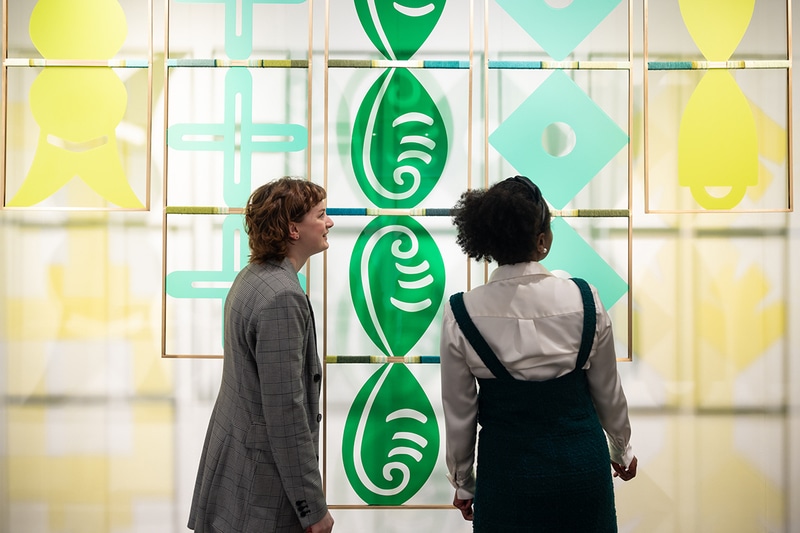
Claudia Peña Salinas
CURRO, Guadalajara
Atli Temoayan series, 2024
Brass, plexiglass and dyed cotton thread. 100 x 190 inches (240 x 420 x 1 cm)
Courtesy of the artist and CURRO, Guadalajara.
Claudia Peña Salinas works with sculpture, installation, and video to explore the symbolism and mythology of the Ancient Americas. The title of this suspended seven-part structure refers to recurring pictorial symbols or glyphs representing the Aztec water deity, Chalchiuhtlicue. These glyphs are sourced from surviving Aztec codices depicting the deity. Instead of relying on direct representation, the sculpture embraces an abstract interpretation of the body using elements such as water, jade, gold, rain, and reptile designs. This artistic approach prioritizes symbolic motifs and the use of these materials to evoke the significance and symbolism associated with the deity. Additionally, the verticality of the sculpture conveys the imagery of a waterfall, a theme that is also explored in other hanging artworks of similar nature. Together, the motifs prove ancestral knowledge is more complex and layered than what can be represented through western documentation.
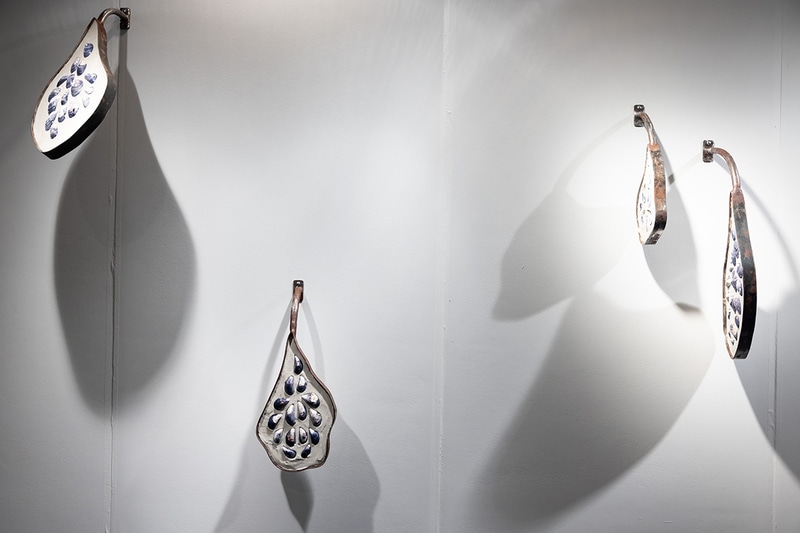
Tori Wrånes
Nazarian / Curcio, Los Angeles
Mussel Tears, 2021
Steel, concrete, mussels. 31 x 4.5 x 15 inches each
Courtesy of the artist and Nazarian / Curcio, Los Angeles.
The four forms that protrude from the wall in Tori Wranes’s sculpture Mussel Tears echo natural structures. Made from glazed concrete, steel, and mussel shells, it draws on an otherworldly array of characters, blending fact, fiction, and myth. Each object features a rounded shape that tapers to a point at the top, suggesting teardrops in an expression of grief for the loss of marine and other habitats. Common in the waters of the southern Norwegian coastal fishing towns where Wrånes grew up, the mussel might also here represent a subtle homage to Marcel Broodthaers, who is known for incorporating mollusks into his work. Each shell is broken open and embedded point facing up in the concrete, thus reinforcing the overall teardrop shape. This doubling also mirrors the relationship between humans and non-humans in a humble meditation on the interconnectedness of our ecosystems.

Lauren Yeager
Abattoir, Cleveland
Infinite Column, 2022
Found objects, 19 x 12x 95 in.
Courtesy of the artist and Abattoir, Cleveland.
Lauren Yeager is a sculptor whose work with salvaged everyday materials makes reference to classical and modernist sculpture. Infinite Column alludes to a sequence of sculptures by Constantin Brâncuși featuring stacked cubic forms that was the model for a 98-foot public monument in Romania in 1938. Yeager’s work however lacks the stability of its twentieth-century counterpart, appearing instead to have been improvised from materials at hand. Incorporating Styrofoam and plastic storage containers placed in inverted pairs, the work echoes the symmetrical rhythm of its namesake but transcends art-historical parody and pastiche to embody and critique the wastefulness of single-use plastics and composite synthetics.